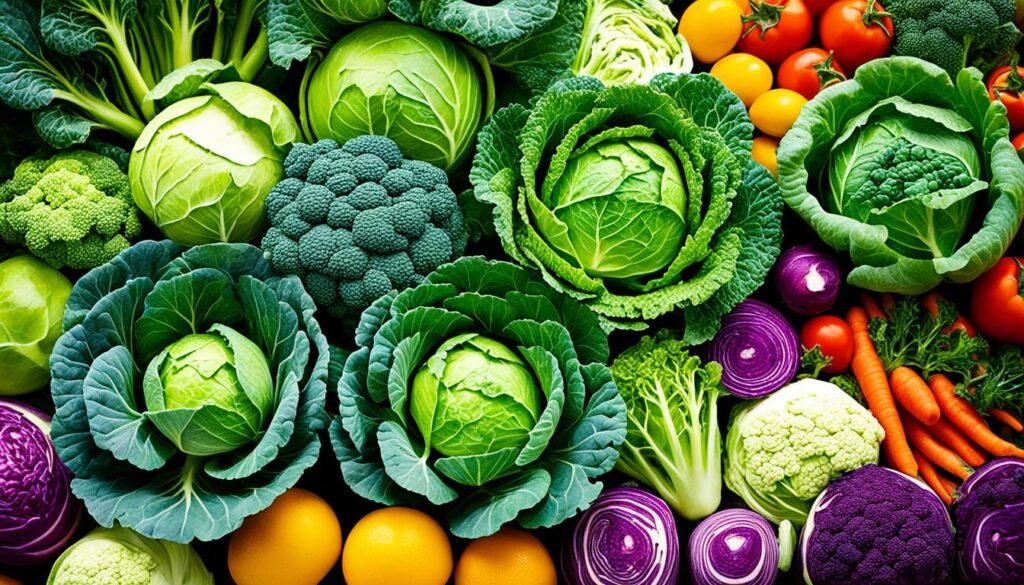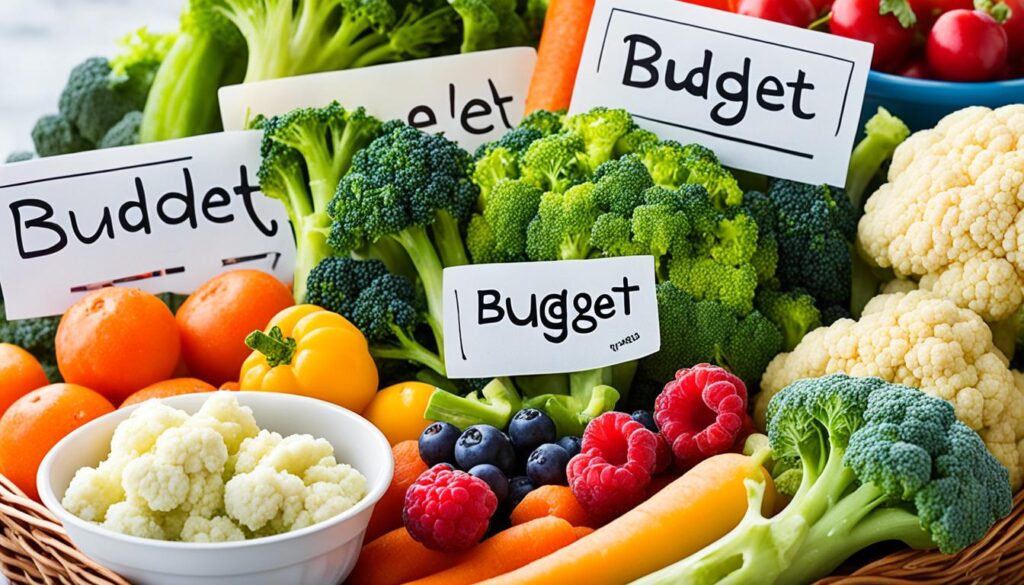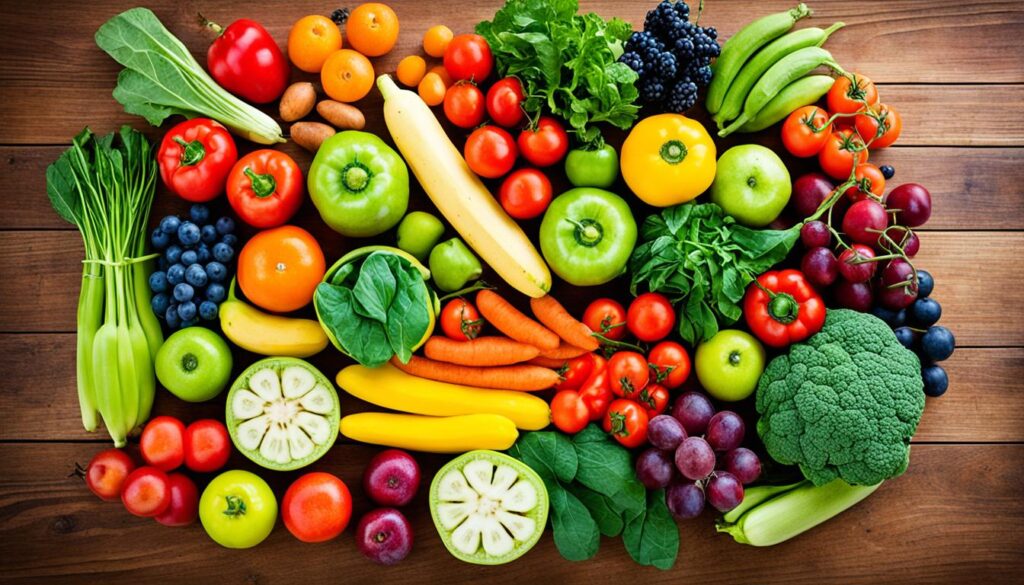Are you tired of the misconception that eating healthy means breaking the bank? Prepare to be pleasantly surprised! This comprehensive guide will reveal a wealth of affordable, nutrient-dense foods that can support your weight loss journey without sacrificing your budget. Discover how to fill your plate with a delicious array of vegetables, grains, and legumes that not only nourish your body but also your wallet. Get ready to embark on a cost-effective culinary adventure that will have you feeling your best, all while saving a few extra dollars1.
Key Takeaways
- Discover budget-friendly, nutrient-dense foods that can support weight loss
- Learn practical strategies for grocery shopping and meal planning on a tight budget
- Explore affordable yet delicious ways to incorporate more vegetables, grains, and legumes into your diet
- Understand the importance of a heart-healthy diet and how it can prevent diseases like Type 2 diabetes
- Uncover the benefits of frozen and canned produce as cost-effective alternatives to fresh
Vegetables as Budget-Friendly Nutritional Powerhouses
When it comes to building a healthy, budget-friendly diet, vegetables stand out as nutritional powerhouses that won’t break the bank. From broccoli to onions, these affordable produce options are packed with essential vitamins, minerals, and antioxidants that can support overall wellness. Let’s explore the benefits of two particularly cost-effective and nutrient-dense veggie choices.
Broccoli: A Vitamin-Packed Superfood
Broccoli is an excellent choice for those seeking affordable, nutrient-dense produce. At just $1.92 per pound on average2, this bright green vegetable is rich in a variety of essential vitamins and minerals. Broccoli is an exceptional source of vitamin C, which acts as a powerful antioxidant and supports immune function3. It also provides substantial amounts of vitamin K and folate, two nutrients crucial for blood clotting and preventing neural tube defects3. Studies suggest that the unique blend of phytochemicals and antioxidants in broccoli may help reduce the risk of chronic illnesses like cancer and heart disease3.
Onions: Flavorful Antioxidant Boosters
Another budget-friendly vegetable that packs a nutritional punch is the humble onion. Costing around $1.05 per pound on average2, onions are renowned for their impressive antioxidant content, which can provide protection against allergies, inflammation, arthritis, cardiovascular disorders, and certain types of cancer3. In addition to their antioxidant properties, onions contain small amounts of various vitamins and minerals, including vitamin C, manganese, vitamin B6, and potassium3. Their versatility and ability to enhance the flavor of many dishes make onions a valuable addition to any healthy, budget-conscious kitchen.
By incorporating affordable, nutrient-dense vegetables like broccoli and onions into your meals, you can enjoy the benefits of a healthy diet without breaking the bank. These budget-friendly superfoods offer a wealth of essential vitamins, minerals, and antioxidants that can support overall well-being234.
Maximizing Greens: Bagged Spinach for Minimal Cost
When it comes to affordable and nutrient-dense greens, bagged spinach stands out as a budget-friendly powerhouse. At around $3.83 per pound5, spinach is a versatile and vitamin-rich addition to any healthy diet. This leafy green is packed with essential nutrients, including a remarkable 1000% of the daily recommended intake of vitamin K in just 1 cup of cooked spinach6. Spinach also provides a significant boost of vitamins A and C, as well as folate and manganese, making it a true nutrient-dense vegetable.
Beyond its impressive nutrient profile, spinach has been shown to offer numerous health benefits. Studies have found that consuming spinach can lower the risk of non-alcoholic fatty liver disease5. The beneficial plant compounds in spinach also have anti-inflammatory properties and can help prevent cell damage, reducing the risk of chronic diseases5. Incorporating this affordable and vitamin-rich vegetable into your meals is an easy way to boost your nutrient intake without breaking the bank.
Bagged spinach is not only cost-effective but also incredibly versatile. Spinach can be enjoyed raw in salads, sautéed as a side dish, or even added to soups, stews, and pasta dishes6. Its ability to be consumed both raw and cooked provides flexibility in meal preparation, ensuring you can maximize the nutritional benefits of this budget-friendly leafy green.
When planning your meals on a budget, remember that affordable spinach, along with other nutrient-dense greens and budget-friendly leafy vegetables, can be a valuable addition to your vitamin-rich produce lineup. By incorporating these affordable and nutritious options into your diet, you can enjoy the benefits of healthy eating without compromising your wallet567.
Spuds and Sweet Potatoes: Nutrient-Dense Staples
When it comes to affordable and nutrient-dense starches, two versatile options stand out: russet potatoes and sweet potatoes. These budget-friendly staple foods provide an impressive array of essential vitamins, minerals, and fiber, making them valuable additions to any weight loss or healthy eating plan.
Russet Potatoes: Packed with Potassium and Fiber
Russet potatoes are an excellent source of potassium-rich produce, with a medium-sized russet potato containing nearly twice the amount of potassium found in a banana8. In fact, less than 0.015% of American adults meet their daily potassium needs8. Russet potatoes are also a good source of fiber, which supports healthy digestion and appetite control. With an average price of $0.60 per pound, russet potatoes are a budget-friendly option that packs a nutritional punch.
Sweet Potatoes: Vitamin A Powerhouses
Another affordable and nutrient-dense staple is the humble sweet potato. Costing around $1.05 per pound9, sweet potatoes are particularly high in beta-carotene, which is converted into vitamin A in the body. Just one sweet potato provides a remarkable 369% of the daily need for vitamin A8, which is essential for eye health and immune function. Sweet potatoes also contain a decent amount of B vitamins, vitamin C, potassium, and fiber, making them a versatile and budget-friendly winter vegetable.
Both russet and sweet potatoes are nutrient-dense starches that can be incorporated into a variety of dishes, from roasted fries to hearty soups. With their affordable prices and impressive nutritional profiles, these potassium-rich and anti-inflammatory produce options are excellent choices for those looking to eat healthy on a budget.
Canned Tomatoes: Versatile and Vitamin-Rich
When it comes to affordable, nutrient-dense produce, canned tomatoes deserve a place in your pantry. Costing around $0.91 per pound on average10, these budget-friendly vegetables are a powerhouse of essential vitamins and minerals. A one-cup serving of canned tomatoes provides a remarkable 37% of your daily vitamin C needs10, making them a fantastic source of this immune-boosting nutrient.
But the benefits of canned tomatoes don’t stop there. They also contain a wealth of B vitamins, vitamins A, E, and K, as well as various trace minerals10. Studies have shown that incorporating these lycopene-rich foods into your diet may help reduce “bad” LDL cholesterol and blood pressure levels, two primary risk factors for heart disease10. Tomatoes’ health-promoting properties are largely attributed to their high concentration of lycopene, a powerful antioxidant that can help protect cells from damage and lower the risk of chronic diseases10.
With their versatility and affordable price point, canned tomatoes are a smart addition to any budget-friendly, nutrient-dense meal plan. From pasta sauces and soups to stews and casseroles, these vitamin-packed pantry staples can elevate a wide range of dishes while supporting your overall health and weight management goals10.
| Canned Tomato Product | Cost Range |
|---|---|
| 14.5 oz can of canned tomatoes | $0.69 – $2.4911 |
| 6 oz can of tomato paste | $0.79 – $0.8911 |
| 8 oz can of tomato sauce | $0.39 – $0.4911 |
By incorporating these affordable, nutrient-dense canned tomatoes into your weekly meal planning, you can enjoy the benefits of lycopene-rich foods without breaking the bank10. With their versatility and cost-effectiveness, canned tomatoes are a smart choice for those looking to maintain a healthy, budget-friendly diet.
Root Veggies: Carrots and Their Carotenoid Riches
When it comes to affordable and nutrient-dense root vegetables, carrots reign supreme. On average, carrots cost around $0.77 per pound12, making them a budget-friendly addition to any healthy diet. Beyond their wallet-friendly price tag, carrots are one of the richest sources of beta-carotene, a powerful antioxidant responsible for their vibrant orange hue13.
Just one cup of carrots provides a remarkable 119% of the daily recommended intake of vitamin A, a vital nutrient for maintaining good eyesight and a robust immune system12. Carrots also boast significant amounts of fiber, vitamin C, vitamin K, potassium, and manganese, making them a true nutritional powerhouse among budget-friendly produce12.
Emerging research suggests that the antioxidant properties of carrots may even help decrease inflammation and reduce the risk of certain types of cancer, such as stomach cancer12. With their versatility, affordability, and impressive nutrient profile, it’s no wonder carrots are a staple in many households striving for healthy eating on a budget.
To maximize the benefits of this vitamin A-rich root vegetable, consider incorporating carrots into soups, stews, roasted veggie medleys, or even enjoying them as a refreshing, crunchy snack. By adding affordable, nutrient-dense carrots to your grocery list, you can nourish your body without breaking the bank121413.
Green Cabbage: An Affordable Cruciferous Gem
When it comes to budget-friendly, nutrient-dense vegetables, green cabbage stands out as a true gem. This affordable cruciferous vegetable is not only easy on the wallet but also packed with an impressive array of health benefits15.
Cabbage is highlighted as a budget-friendly option, being affordable and low in calories while being high in nutrients15. In fact, green cabbage can be purchased for around $0.62 per pound on average, making it a cost-effective addition to any meal plan16.
Butternut Squash: A Nutrient-Dense Winter Treat
Another winter staple that offers exceptional nutritional value is butternut squash. This nutrient-dense winter squash is not only affordable but also boasts an impressive array of health benefits. Butternut squash is rich in vitamins A and C, as well as fiber and antioxidants, making it a stellar choice for those seeking budget-friendly, anti-cancer produce15.
Cooking cabbage in an Instant Pot can make it soft and tender in just a few minutes, and this method helps retain more nutrients compared to boiling16. Using broth instead of water to cook cabbage also adds more flavor to the dish16. With the ability to achieve different textures, from slightly crisp to very soft, the Instant Pot offers a convenient way to incorporate this affordable vegetable into a variety of meals16.
Cabbage pairs well with a wide range of ingredients, including carrots, apples, onions, and various herbs and spices, making it a versatile and budget-friendly addition to any recipe16. Whether you choose to enjoy it raw, roasted, or in a hearty soup, green cabbage and nutrient-dense winter squash offer an affordable and nutritious way to support your health and weight loss goals15.

Whole Grains on a Shoestring: Brown Rice and Oatmeal
When it comes to affordable whole grains, brown rice and oatmeal stand out as two of the most budget-friendly carbohydrates that are also nutrient-dense starches and fiber-rich foods. On average, these whole grain options cost around $2 per pound, making them accessible choices for those looking to eat healthily on a tight budget17.
Brown rice is primarily composed of carbohydrates, providing 3.23 grams of fiber per cup17. It also offers a decent amount of B vitamins, magnesium, phosphorus, and manganese, making it a nutritional powerhouse. Numerous studies have indicated that incorporating brown rice into one’s diet can help reduce the risk of type 2 diabetes and heart disease, as well as promote weight control17.
Similarly, oatmeal is another excellent whole grain option that is affordable and nutrient-dense. This versatile fiber-rich food can be enjoyed in various forms, from classic oatmeal to overnight oats, providing a satisfying and wholesome start to the day18.
By incorporating affordable whole grains like brown rice and oatmeal into your diet, you can enjoy the benefits of budget-friendly carbohydrates, nutrient-dense starches, and fiber-rich foods without breaking the bank171819.
Remember, smart grocery shopping strategies, such as meal planning, bulk buying, and prioritizing store brands, can further enhance the affordability of these whole grain options19.
“Whole grains like brown rice and oatmeal are not only affordable but also packed with essential nutrients that can support weight loss and overall health.”
Canned Beans and Lentils: Protein-Packed Plant Power
When it comes to affordable and nutrient-dense foods for weight loss, canned beans and dried lentils stand out as budget-friendly powerhouses20. These plant-based proteins are not only easy on the wallet but also packed with fiber, vitamins, and minerals that can support your health and weight management goals.
Canned Beans: Versatile and Fiber-Filled
Canned beans are a convenient and cost-effective option, often costing less than $1 per pound20. These legumes are a fantastic source of plant-based protein, with a single cup of black beans providing a substantial 14.5 grams20. Additionally, beans are rich in fiber, which can help keep you feeling full and satisfied, making them an ideal choice for those looking to lose weight21. The fiber in beans may also play a role in reducing the risk of chronic diseases, such as heart disease and type 2 diabetes21.
Dried Lentils: Nutrient-Dense and Budget-Friendly
Dried lentils are another budget-friendly and nutrient-dense option, costing around $1.56 per pound on average20. A cup of cooked lentils delivers an impressive array of essential nutrients, including 90% of the daily need for folate, 37% for iron, 55% for copper, and 43% for manganese21. Lentils are also an excellent source of plant-based protein and fiber, making them a filling and weight-control-friendly food21. Research suggests that the nutrients in lentils may help reduce the risk of chronic diseases, such as heart disease and type 2 diabetes21.
Incorporating canned beans and dried lentils into your meal planning can be a game-changer for healthy eating on a budget. Whether you’re looking to lose weight, improve your overall health, or simply save money, these nutrient-dense legumes are a versatile and affordable option that can help you achieve your goals22.
Healthy Eating on a Budget: Affordable Foods for Weight Loss
When it comes to achieving weight loss goals, a common misconception is that healthy eating must come at a premium cost. However, with some strategic planning and a focus on nutrient-dense, budget-friendly ingredients, it’s entirely possible to lose weight without breaking the bank23.
The key is to incorporate a variety of affordable, whole foods into your diet. Nutrient-rich vegetables like broccoli, onions, spinach, carrots, and cabbage are not only packed with essential vitamins and minerals but also incredibly cost-effective24. Whole grains, such as brown rice and oatmeal, provide sustained energy and fiber, while canned beans and lentils offer budget-friendly protein and fiber24.
It’s also important to consider the power of plant-based proteins, which can be significantly more affordable than their animal-based counterparts24. Incorporating these nutrient-dense, budget-friendly foods into your meals can help you lose weight in a sustainable, cost-effective manner.
Beyond the food itself, strategies like meal planning, bulk buying, and repurposing leftovers can also go a long way in keeping your healthy eating on a budget24. By taking a holistic approach to your nutrition, you can enjoy the benefits of weight loss without sacrificing your financial well-being.

Remember, the key to successful weight loss on a budget is to focus on nutrient-dense, affordable whole foods that nourish your body while also supporting your financial goals. With a little creativity and planning, you can achieve your health and wellness objectives without breaking the bank232425.
Grocery Shopping Strategies for Healthy Eating on a Budget
Maintaining a healthy diet doesn’t have to break the bank. With the right budget-friendly grocery shopping strategies, you can enjoy nutritious meals without compromising your wallet. The key to eating well on a tight budget lies in strategic meal planning and savvy bulk buying.
Meal Planning: The Key to Budget-Friendly Nutrition
Meal planning is a powerful tool for cost-effective healthy eating. By deciding on your weekly meals and making a comprehensive grocery list, you can avoid impulse purchases and reduce the likelihood of relying on expensive convenience foods26. Meal planning also allows you to identify ingredients that can be used in multiple recipes, maximizing your budget.
Bulk Buying: Stocking Up on Staples
Buying in bulk is another effective way to save money while eating healthy. Bulk supermarkets often offer significant savings on foods like rice, canned goods, pasta, and spices that have a long shelf life26. When it comes to perishable items like produce and meat, buying in bulk can also be beneficial if you have the means to properly store and preserve them, such as by freezing. However, it’s crucial to avoid bulk buying of less healthy items that could tempt you to overindulge.
By incorporating these grocery shopping strategies, you can enjoy a nutritious diet without breaking the bank.262728
Repurposing Leftovers: Maximizing Every Bite
In a world where budgets are tight and food waste is a growing concern, the art of repurposing leftovers becomes a powerful tool in the kitchen. By embracing the potential of leftover ingredients, you can not only save money but also reduce food waste, all while crafting delicious and versatile meals29.
One of the keys to making the most of your leftovers is proper storage. Ensuring that your leftovers are stored in airtight containers, whether in the refrigerator or freezer, can extend their shelf life and maintain their quality. This simple step can transform yesterday’s meal into a valuable ingredient for tomorrow’s culinary creation30.
Repurposing leftovers often involves a bit of creativity and a willingness to think outside the box. Perhaps that extra grilled chicken from last night can be shredded and incorporated into a hearty salad or a batch of flavorful tacos. Leftover roasted vegetables might find new life as the foundation for a warm and comforting soup or a nutritious stir-fry. The possibilities are endless when you approach your leftovers with a mindset of resourcefulness and culinary exploration30.
Another way to maximize the value of your leftovers is to plan ahead. When preparing your meals, consider how the components can be used in future dishes. Cooking extra rice or pasta, for instance, can provide a ready-to-use base for a variety of leftover-based meals. By embracing this mindset of “cooking for two,” you can transform a single meal into multiple cost-saving and time-efficient options30.
Remember, the key to successful leftover repurposing is to approach it with a spirit of creativity and experimentation. Embrace the challenge of transforming familiar ingredients into new and exciting dishes, and you’ll soon find yourself saving money, reducing food waste, and expanding your culinary repertoire all at the same time30.
In the pursuit of budget-friendly and sustainable eating, repurposing leftovers stands as a shining example of how small actions can yield significant rewards. By harnessing the power of your leftover ingredients, you unlock a world of cost-saving meal prep, reduced food waste, and delightfully versatile recipe ideas2930.
Frozen Fruits and Veggies: Nutrition on Ice
Buying affordable frozen produce is one of the easiest ways to enjoy budget-friendly nutrition. Research shows that the overall vitamin content of frozen fruits and vegetables is often the same or even higher than their fresh counterparts31. Frozen items also have a longer shelf life, reducing the risk of food waste31.
While some nutrients like beta-carotene may decrease slightly in frozen foods, there is generally no significant disadvantage to purchasing nutrient-dense frozen foods, especially when they are the more cost-effective option31. Freezing fruits and vegetables at their peak ripeness helps retain essential vitamins and minerals, making frozen options just as nutritious as fresh produce31.
Frozen foods can be an affordable way to consume more fruits and vegetables, with frozen berries being just as nutritious and much more affordable than fresh berries31. Convenience is a key benefit of frozen foods, saving time on meal preparation, especially with busy lifestyles31.
However, it’s important to be aware that some frozen meals may be high in sodium or added sugars, so reading Nutrition Facts labels is essential31. Proper storage of frozen foods is crucial for maintaining quality, and the USDA emphasizes the importance of packaging and rapid freezing to prevent freezer burn31.

While frozen foods offer many advantages, it’s important to choose wisely and be mindful of potential downsides. By incorporating a variety of affordable frozen produce into your diet, you can enjoy budget-friendly nutrition and the convenience of cost-effective meal prep31.
Plant-Based Proteins: Cost-Effective Alternatives
Meat can be one of the more expensive grocery items, but incorporating affordable plant-based protein sources like32 beans, lentils, and tofu can be a cost-effective solution. These nutrient-dense legumes are packed with fiber, antioxidants, and33 around 7-10 grams of protein per serving, making them a budget-friendly meat alternative33. Dry beans are even more cost-effective than canned, providing more servings per pound.
For those who still wish to include some animal-based proteins in their diet32, buying less tender cuts of meat or choosing33 affordable sources of tofu and tempeh from Asian markets can also help stretch your budget33. Whole grains like oats, brown rice, and quinoa are another economical source of plant-based carbohydrates and fiber.
33 Meal planning, cooking at home, tracking spending, sticking to a budget, and meal prepping are essential strategies for a cost-effective plant-based diet32. The provided 1,200-calorie meal plan aims to help individuals lose 1 to 2 pounds per week while maintaining a budget-friendly approach, with a per-serving cost for the whole week at $50 and daily costs ranging from $4.96 to $9.62.
| Affordable Plant-Based Proteins | Nutritional Value | Cost-Saving Tips |
|---|---|---|
| Beans (black, kidney, etc.) | High in protein, fiber, and antioxidants | Opt for dry beans over canned for more servings per pound |
| Lentils | Nutrient-dense and budget-friendly | Purchase from the grocery store’s bulk section |
| Tofu and Tempeh | Excellent plant-based protein sources | Check Asian markets for affordable options |
| Whole Grains (oats, brown rice, quinoa) | Provide complex carbs, fiber, and plant-based nutrients | Buy in bulk to save money |
33 Studies have shown that a low-fat vegan diet supports weight loss and aids in reducing BMI, with a significant weight loss difference observed between plant-based diet followers and omnivores33. Following a plant-based diet can also significantly lower the risk of high cholesterol, as recommended by the American Heart Association.
“When prepared from scratch, a plant-based diet is affordable, especially with rising costs of animal-based products.”33
34 The FAO’s report “How to Feed the World in 2050” presents crucial information regarding future food security challenges, highlighting the potential of proteins from land plants as vital resources for human nutrition and food security.
33 Affordable plant-based foods for budget-friendly grocery shopping include beans, peas, lentils, potatoes, carrots, corn, onions, garlic, frozen fruits, bananas, oranges, tomato sauce, tomato paste, peanut butter, oatmeal, brown rice, pasta, and noodles.
By incorporating these cost-effective, nutrient-dense legumes and whole grains into your diet, you can enjoy the benefits of a plant-based lifestyle without breaking the bank32. The provided meal plan showcases strategies to maximize your budget, from bulk purchasing to repurposing ingredients, ensuring you can maintain a healthy33, sustainable, and environmentally-friendly diet.
Store Brands: Quality Nutrition Without the Price Tag
When it comes to eating healthy on a budget, savvy shoppers know that store-brand or private-label items can be a game-changer. These more affordable grocery alternatives are often just as safe, nutritious, and delicious as their name-brand counterparts, yet they typically come with a much lower price tag35.
The reason for these budget-friendly prices lies in the way store brands operate. Grocery stores can offer these products at a reduced cost due to factors like decreased advertising expenses, minimal research and development, and streamlined transportation logistics36. By swapping out a few name-brand items for their store-brand equivalents, you can enjoy quality nutrition without the premium price.
- Canned tomatoes, for instance, can cost less than $2 per can for store brands35.
- Oats, a nutritional powerhouse, provide a serving of B vitamins, iron, manganese, phosphorus, zinc, and magnesium35.
- Peanut butter is a budget-friendly source of plant-based protein, heart-healthy fats, vitamin E, and B vitamins35.
- Beans, which cost around $15 per cup, are rich in fiber, folate, iron, magnesium, and potassium35.
The savings don’t stop there. Potatoes, often costing less than $5 for a 5-pound bag, are high in potassium35. Lentils, an affordable and nutrient-dense option, provide protein, fiber, iron, and manganese35. Even popcorn, a low-calorie snack rich in fiber and antioxidants, can be a budget-friendly choice35.
When it comes to frozen fruits and vegetables, the store-brand options are just as nutritious as their name-brand counterparts, if not more so. These frozen gems are loaded with antioxidants and linked to various health benefits, all while costing a fraction of the price35.
By embracing store-brand products, you can enjoy high-quality nutrition without the hefty price tag. From canned tuna to eggs, these budget-friendly alternatives provide a wide range of essential nutrients while helping you save money on your grocery bill35. With a little savvy shopping, you can incorporate affordable store-brand products into your healthy eating plan and achieve your wellness goals without breaking the bank.
“Healthy choices do not need to come with a hefty price tag.” – Mary Alice Cain, Registered Dietitian at Dollar General36
Conclusion
In conclusion, eating healthy on a tight budget is entirely possible with the right strategies and a focus on affordable, nutrient-dense foods. By incorporating a variety of budget-friendly vegetables, whole grains, legumes, and other nutritious ingredients into your meals, you can nourish your body without breaking the bank37. The average daily cost of healthy menus in the study ranged from $19 to $31 if all items were purchased from a bulk supermarket, with an average daily cost of $2537. Additionally, practical grocery shopping tactics like meal planning, bulk buying, and utilizing store-brand products can help you maximize your food budget and enjoy the benefits of a healthy diet.
The study found that healthier foods were estimated to be $1.48 more expensive per day for the top quintile of individuals compared to the bottom quintile37. However, by making strategic choices and leveraging cost-effective options, you can achieve affordable healthy eating and cost-effective weight loss38. A comprehensive review found that unhealthy food is approximately $1.50 cheaper per day than healthy food, but making informed decisions can help offset these differences.
Ultimately, with a focus on budget-friendly nutrition, you can develop a sustainable and healthy eating plan that aligns with your financial constraints. By implementing money-saving grocery strategies, such as meal planning, bulk buying, and utilizing store brands, you can enjoy the benefits of a nutrient-rich diet without sacrificing your budget39. By reducing eating out frequency and incorporating more affordable, plant-based proteins, you can further optimize your spending on healthy foods and achieve your wellness goals.
FAQ
What are some affordable yet nutritious vegetables for weight loss?
Affordable and nutrient-dense vegetables for weight loss include broccoli, onions, spinach, russet potatoes, sweet potatoes, carrots, and green cabbage.
How can canned tomatoes be a budget-friendly and nutritious option?
Canned tomatoes are relatively inexpensive and provide a significant amount of vitamins, minerals, and the antioxidant lycopene, which can help reduce inflammation and the risk of chronic diseases.
What are the benefits of incorporating whole grains like brown rice and oatmeal into a budget-friendly diet?
Brown rice and oatmeal are affordable whole grain options that provide fiber, B vitamins, and minerals. They can help reduce the risk of type 2 diabetes and heart disease, as well as promote weight control.
How can canned beans and dried lentils be cost-effective sources of plant-based protein?
Canned beans and dried lentils are inexpensive sources of protein, fiber, and various vitamins and minerals. They are associated with a reduced risk of heart disease and diabetes, likely due to their ability to lower cholesterol and promote blood sugar control.
What are some effective grocery shopping strategies for eating healthy on a budget?
Strategies include meal planning, bulk buying of non-perishable items, repurposing leftovers, purchasing frozen fruits and vegetables, choosing plant-based protein sources, and opting for store-brand or private-label products.
Source Links
- 28 Healthy Foods That Are Incredibly Cheap
- 10 Healthy, Budget-Friendly Foods a Dietitian Always Has in Her Kitchen
- Healthy Grocery List on a Budget: 52 Affordable Foods
- Six Budget-Friendly Plant-Based Foods for Sustainable Eating
- Strategies for Eating Well on a Budget
- How Inexpensive Leafy Greens Help Support Good Health – Under the Median
- Bulking on a Budget
- Potassium Rich Foods: 18 Foods High in Potassium
- The 10 Cheapest, Healthiest Foods You Can Find In Any Grocery Store
- The 9 Best Canned Foods You Should Be Eating for Weight Loss, According to Dietitians
- Best Budget-Friendly Foods for the Pantry – Tomato Wellness
- 12 Foods with the Healthiest Bang for Your Buck
- Best bang for buck vegetables, according to a dietitian
- 20 budget-friendly superfoods
- Roasted Cabbage Steaks with Savory Peanut Sauce (vegan & gluten free) – Justine Cooks Vegan
- Easy Instant Pot Cabbage Side Dish
- Meal Prep on a Budget: Try These 10 Healthy and Affordable Meal-Prepping Tips
- Tight-Budget Whole Food Plant-Based Recipes
- Nourishing Your Body and Wallet: A Guide to Eating Healthy on a Budget
- Healthy Eating On a Budget: Weight Loss Shopping Simplified
- 7-Day Plant-Based Diet Meal Plan for Beginners, Created by a Dietitian
- 7-Day Clean-Eating Vegetarian Meal Plan for Weight Loss, Created by a Dietitian
- 6 Tips to Lose Weight on a Budget
- Eating healthy on a tight budget: 6 top tips
- 50 Cheap, Healthy Meals You’ll Want to Make This Week
- Eat Smart, Spend Less: Guide to a Budget Friendly Healthy Grocery Haul
- 19 Clever Ways to Eat Healthy on a Tight Budget
- I’m a Dietitian on a Budget & This Is How I Always Organize My Grocery List
- Eat Well on a Budget: Affordable and Nutritious Travel Meals | ConnectPls
- Easy Frugal Cooking Techniques That Save Hundreds of Dollars – Under the Median
- The cold, hard facts about frozen foods
- Vegan Weight-Loss Meal Plan on a Budget
- A Cheap Plant-Based Diet for Beginners
- Sustaining Protein Nutrition Through Plant-Based Foods
- 10 Cheap & Healthy Foods to Buy, According to a Dietitian
- Better For You – Eating Healthy on a Budget
- Yes we can. Eating healthy on a limited budget
- The Cost of Healthy Eating vs Unhealthy Eating – The Plutus Foundation
- Eat Healthy on a Budget! Affordable Nutrition for Your Wallet and Waistline


